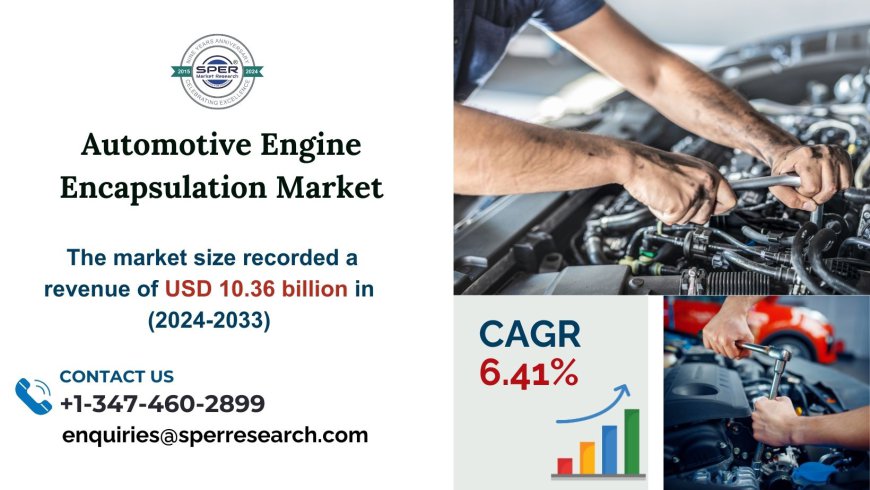Automotive Engine Encapsulation Market to Hit USD 10.36 billion by 2033, Driven by a CAGR of 6.41% Growth Rate: SPER Market Research
Global Automotive Engine Encapsulation Market Size, Revenue, Growth Drivers, Share, CAGR Status, Business Challenges and Future Opportunities

Car engine encapsulation is a process that increases engine efficiency and performance by minimizing heat loss, lowering noise levels, and improving overall thermal management. Manufacturers are under pressure to meet environmental regulations and consumer demands for quieter vehicles, so engine encapsulation is becoming more and more important. Advanced polymers and composites that offer strength and low weight are important materials. The industry is driven by the growing production of hybrid and electric cars, which require effective heat management technologies. Innovations in encapsulating materials are anticipated to improve performance and sustainability as technology advances, making them a vital field in automobile engineering and manufacturing.
According to SPER Market Research, ‘Global Automotive Engine Encapsulation Market Size- By Vehicle Type, By Material Type, By Fuel Type - Regional Outlook, Competitive Strategies and Segment Forecast to 2033’ states that the Global Automotive Engine Encapsulation Market is estimated to reach USD 10.36 billion by 2033 with a CAGR of 6.41%.
Drivers: Automotive engine encapsulation is a market driven mainly by the rapid rise in sales of cars with improved aerodynamics and fuel economy. Manufacturers in the sector are seeing opportunities as a result of this rise. Government policies that encourage the use of energy-efficient components are mostly to blame for the global growth of the vehicle engine encapsulation industry. As the engine powers every vehicle, engine encapsulation has established itself near the engine. Due to the significant rise in sales of fuel-efficient and aerodynamically efficient cars, manufacturers are expected to find opportunities in the market for engine encapsulation. Traditional materials like plastics and composites are gradually being replaced or improved upon by lightweight, heat-resistant alternatives including sophisticated polymers, foams, and carbon fiber composites.
Request For Free Sample Report @ https://www.sperresearch.com/report-store/automotive-engine-encapsulation-market.aspx?sample=1
Restraints: For the automotive engine encapsulation market to keep expanding and improving, it must overcome a number of challenges. One of the primary issues is the complexity of engine designs, which calls for the creation of more sophisticated encapsulation methods that effectively manage heat and noise. In addition, disruptions in the supply chain and increased material costs can drive up production prices and hinder productivity. Environmental constraints require lightweight, environmentally friendly materials, which could result in resource-intensive innovation. As electric and hybrid vehicles have different encapsulation needs than conventional combustion engines, the switch to them presents additional challenges. Stakeholders in the industry still struggle to balance sustainability, cost, and performance while keeping up with the rapid advances in technology.
The COVID-19 pandemic had a devastating impact on the automotive engine encapsulation business, causing manufacturing stoppages and interruptions in the supply chain. When manufacturing closed and the demand for cars declined, manufacturers found it difficult to secure supply and meet delivery deadlines. As a result, projects were postponed and less money was allocated to developing technologies. However, the pandemic accelerated the switch to electric and hybrid vehicles, which raised the need for efficient heat-reduction technologies. Businesses are being pushed to look into cutting-edge materials for engine encapsulation as a result of increased emphasis being paid to sustainability and innovation as the industry recovers.
Key Players:
The Unites States dominates the Global Automotive Engine Encapsulation Market due to its large automotive industry and advanced technology adoption. Major players in the market are 3M, BASF, Covestro, Dow, Freudenberg, Henkel, Huntsman, Mitsui Chemicals, Roush Industries, Saint-Gobain and Others.
Global Automotive Engine Encapsulation Market Segmentation:
By Vehicle Type: Based on the Vehicle Type, Global Automotive Engine Encapsulation Market is segmented as; Passenger Cars, Light Commercial Vehicles, Heavy Commercial Vehicles, Others.
By Material Type: Based on the Material Type, Global Automotive Engine Encapsulation Market is segmented as; Carbon Fiber, Polyurethane, Polypropylene, Polyamide, Glass wool.
By Fuel Type: Based on the Fuel Type, Global Automotive Engine Encapsulation Market is segmented as; Gasoline, Diesel.
By Region: This research also includes data for North America, Asia-Pacific, Latin America, Middle East & Africa and Europe.
This study also encompasses various drivers and restraining factors of this market for the forecast period. Various growth opportunities are also discussed in the report.
For More Information, refer to below link:-
Automotive Engine Encapsulation Market Outlook
Related Reports:
Follow Us –
LinkedIn | Instagram | Facebook | Twitter
Contact Us:
Sara Lopes, Business Consultant – U.S.A.
SPER Market Research
+1-347-460-2899
